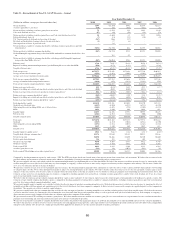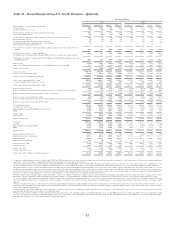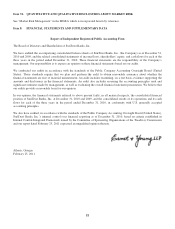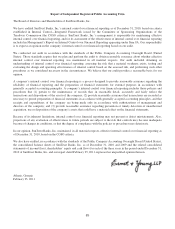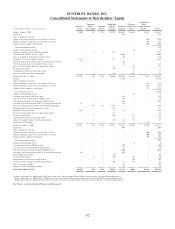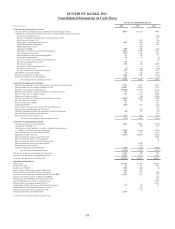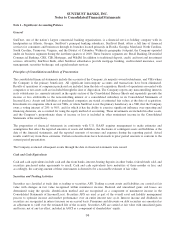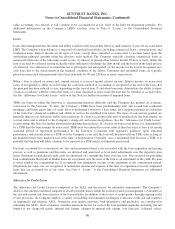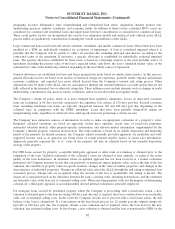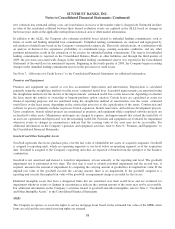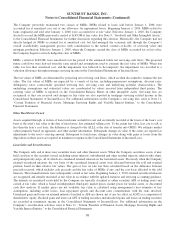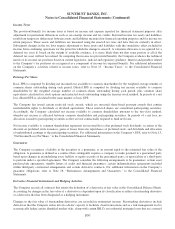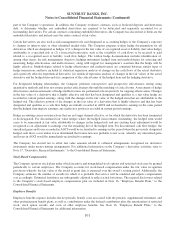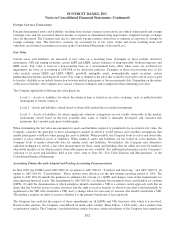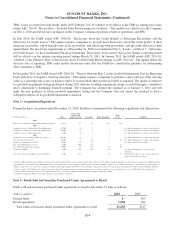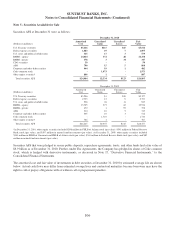SunTrust 2010 Annual Report Download - page 112
Download and view the complete annual report
Please find page 112 of the 2010 SunTrust annual report below. You can navigate through the pages in the report by either clicking on the pages listed below, or by using the keyword search tool below to find specific information within the annual report.SUNTRUST BANKS, INC.
Notes to Consolidated Financial Statements (Continued)
value accounting was elected, it will continue to be accounted for at fair value in the held for investment portfolio. For
additional information on the Company’s LHFS activities, refer to Note 6, “Loans,” to the Consolidated Financial
Statements.
Loans
Loans that management has the intent and ability to hold for the foreseeable future or until maturity or pay-off are considered
LHFI. The Company’s loan balance is comprised of loans held in portfolio, including commercial loans, consumer loans, and
residential loans. Interest income on all types of loans, except those classified as nonaccrual, is accrued based upon the
outstanding principal amounts using the effective yield method. The Company typically classifies commercial loans as
nonaccrual when one of the following events occurs: (i) interest or principal has been in default 90 days or more, unless the
loan is secured by collateral having realizable value sufficient to discharge the debt in full and the loan is in the legal process
of collection; (ii) collection of recorded interest or principal is not anticipated; or (iii) income for the loan is recognized on a
cash basis due to the deterioration in the financial condition of the debtor. Consumer and residential loans are typically
placed on nonaccrual when payments have been in default for 90 and 120 days or more, respectively.
When a loan is placed on nonaccrual, unpaid interest is reversed against interest income. Interest income on nonaccrual
loans, if recognized, is either recorded using the cash basis method of accounting or recognized at the end of the loan after
the principal has been reduced to zero, depending on the type of loan. If and when borrowers demonstrate the ability to repay
a loan in accordance with the contractual terms of a loan classified as nonaccrual, the loan may be returned to accrual status.
See the “Allowance for Credit Losses” section of this Note for further discussion of impaired loans.
TDRs are loans in which the borrower is experiencing financial difficulty and the Company has granted an economic
concession to the borrower. To date, the Company’s TDRs have been predominantly first and second lien residential
mortgages and home equity lines of credit. Prior to modifying a borrower’s loan terms, the Company performs an evaluation
of the borrower’s financial condition and ability to service the modified loan terms. The types of concessions granted are
generally interest rate reductions and/or term extensions. If a loan is accruing at the time of modification, the loan remains on
accrual status and is subject to the Company’s charge-off and nonaccrual policies. See the “Allowance for Credit Losses”
section within this Note for further information regarding these policies. If a loan is on nonaccrual before it is determined to
be a TDR then the loan remains on nonaccrual. TDRs may be returned to accrual status if there has been at least a six month
sustained period of repayment performance by the borrower. Consistent with regulatory guidance, upon sustained
performance and classification as a TDR over the Company’s year end, the loan will be removed from TDR status as long as
the modified terms were market-based at the time of modification. Generally, once a residential loan becomes a TDR, it is
probable that the loan will likely continue to be reported as a TDR until it is ultimately paid in full.
For loans accounted for at amortized cost, fees and incremental direct costs associated with the loan origination and pricing
process, as well as premiums and discounts, are deferred and amortized as level yield adjustments over the respective loan
terms. Premiums for purchased credit cards are amortized on a straight-line basis over one year. Fees received for providing
loan commitments that result in funded loans are recognized over the term of the loan as an adjustment of the yield. If a loan
is never funded, the commitment fee is recognized into noninterest income at the expiration of the commitment period.
Origination fees and costs are recognized in noninterest income and expense at the time of origination for newly-originated
loans that are accounted for at fair value. See Note 6, “Loans,” to the Consolidated Financial Statements for additional
information.
Allowance for Credit Losses
The Allowance for Credit Losses is composed of the ALLL and the reserve for unfunded commitments. The Company’s
ALLL is the amount considered adequate to absorb probable losses within the portfolio based on management’s evaluation of
the size and current risk characteristics of the loan portfolio. In addition to the review of credit quality through ongoing credit
review processes, the Company employs a variety of modeling and estimation techniques to measure credit risk and construct
an appropriate and adequate ALLL. Numerous asset quality measures, both quantitative and qualitative, are considered in
estimating the ALLL. Such evaluation considers numerous factors for each of the loan portfolio segments, including, but not
limited to net charge-off trends, internal risk ratings, changes in internal risk ratings, loss forecasts, collateral values,
96


